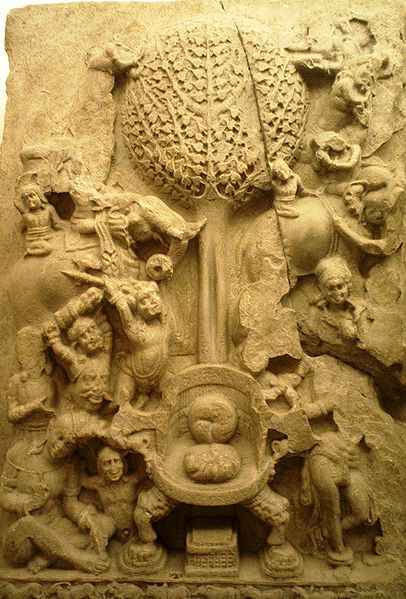Since the beginning of the serious study of the history of Buddhist art in the 1890s, the earliest phase, lasting until the 1st century CE, has been described as aniconic; the Buddha was only represented through symbols such as an empty throne, Bodhi tree, a riderless horse with a parasol floating above an empty space, Buddha's footprints, and the dharma wheel.
Aniconism in Miracle at Kapilavastu: King Suddhodana praying as his son the Buddha rises in the air, praised by celestial beings (but only the Buddha's path, the Chankrama horizontal slab in the air, is visible).
Pillar with Naga Mucalinda protecting the throne of the Buddha. Railing pillar from Jagannath Tekri, Pauni (Bhandara District). 2nd–1st century BCE. National Museum of India.
An aniconic representation of Mara's assault on the Buddha, with an empty throne, 2nd century, Amaravati, India.
Devotions to the empty throne of the Buddha, Kanaganahalli, 1st–3rd century CE
Buddhist art is visual art produced in the context of Buddhism. It includes depictions of Gautama Buddha and other Buddhas and bodhisattvas, notable Buddhist figures both historical and mythical, narrative scenes from their lives, mandalas, and physical objects associated with Buddhist practice, such as vajras, bells, stupas and Buddhist temple architecture. Buddhist art originated in the north of the Indian subcontinent, in modern India, Pakistan and Afghanistan, with the earliest survivals dating from a few centuries after the historical life of Siddhartha Gautama from the 6th to 5th century BCE.
Representation of the Buddha in the Greco-Buddhist art of Gandhara, 1st century CE
Seated Maitreya sculpture, Kathmandu Valley, Nepal, c. 1250–1350
Thangka of Shakyamuni Buddha, Tibet, c. 18th century
Footprint of the Buddha. 1st century BCE, Gandhara








